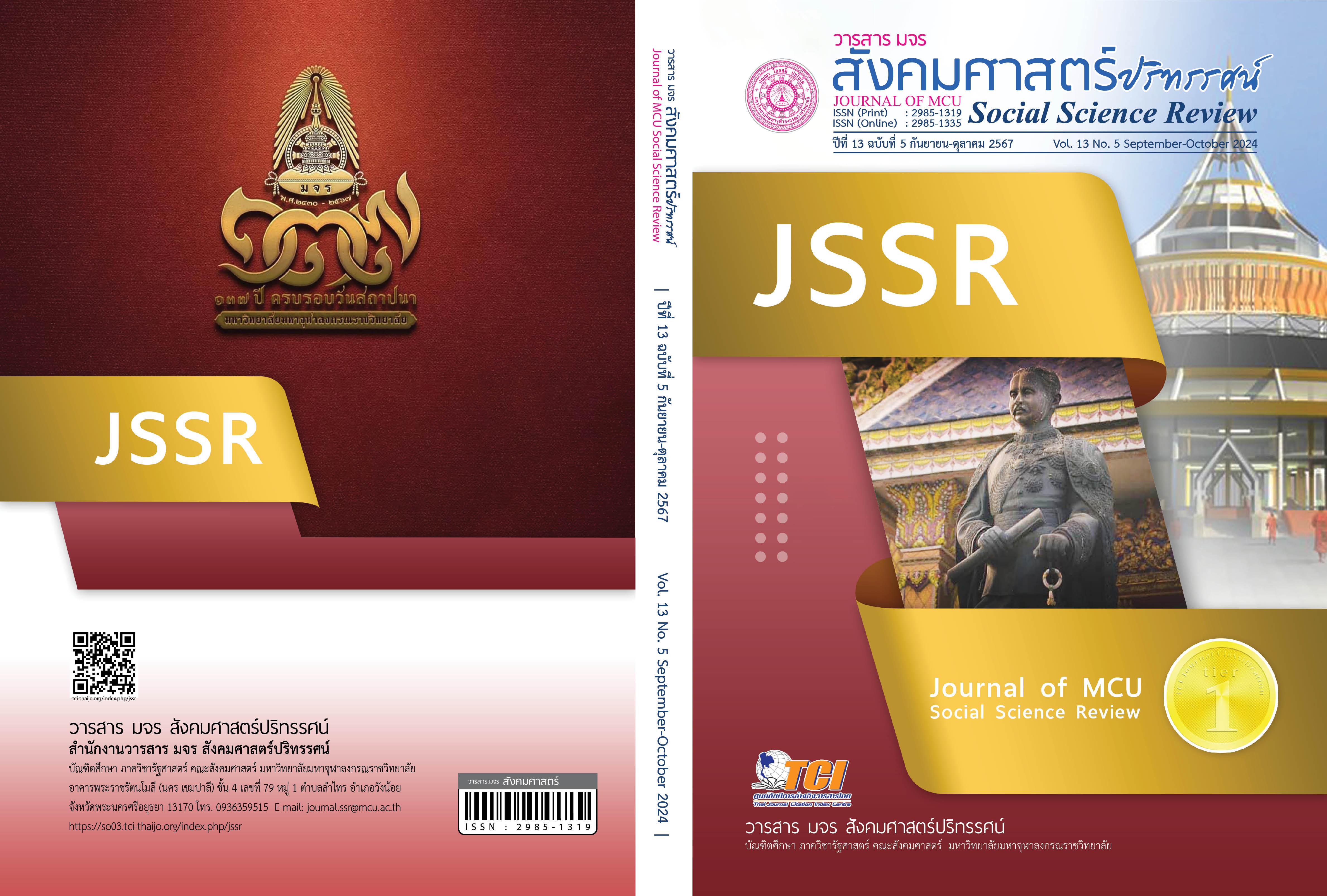การศึกษาผลการจัดการเรียนรู้แบบออนไลน์ที่ส่งเสริมความสามารถ ด้านมิติสัมพันธ์ เรื่อง รูปเรขาคณิตสองมิติและสามมิติสำหรับนักเรียน ชั้นมัธยมศึกษาปีที่ 1 ในสถานการณ์การแพร่ระบาด ของโรคติดเชื้อไวรัสโคโรน่า 2019
คำสำคัญ:
การจัดการเรียนรู้แบบออนไลน์, ความสามารถด้านมิติสัมพันธ์, รูปเรขาคณิตสองมิติและสามมิติบทคัดย่อ
บทความวิจัยนี้มีวัตถุประสงค์เพื่อศึกษาความสามารถด้านมิติสัมพันธ์เรื่อง รูปเรขาคณิตสองมิติและสามมิติ ของนักเรียนชั้นมัธยมศึกษาปีที่ 1 หลังการจัดการเรียนรู้แบบออนไลน์ที่ส่งเสริมความสามารถด้านมิติสัมพันธ์ ประชากรและกลุ่มตัวอย่างที่ใช้ในการศึกษาครั้งนี้ คือ นักเรียนชั้นมัธยมศึกษาปีที่ 1 จำนวน 20 คน เครื่องมือวิจัย คือ แผนการจัดการเรียนรู้แบบออนไลน์ที่ส่งเสริมความสามารถด้านมิติสัมพันธ์ 8 แผน และแบบทดสอบวัดความสามารถด้านมิติสัมพันธ์ การวิเคราะห์ข้อมูลโดยใช้การคำนวณร้อยละ ค่าเฉลี่ย และค่าเบี่ยงเบนมาตรฐาน
ผลการวิจัยพบว่า ความสามารถด้านมิติสัมพันธ์ เรื่อง รูปเรขาคณิตสองมิติและสามมิติ ของนักเรียนชั้นมัธยมศึกษาปีที่ 1 หลังได้รับการจัดการเรียนรู้โดยใช้กิจกรรมการเรียนรู้แบบออนไลน์ที่ส่งเสริมความสามารถด้านมิติสัมพันธ์คะแนนเฉลี่ยคิดเป็น 73.50 ของคะแนนเต็ม นักเรียนส่วนใหญ่มีความเข้าใจในมิติสัมพันธ์ เรื่องการรับรู้ภาพหน้าตัด และการจำแนกภาพด้านหน้า ด้านข้าง ด้านบน ของรูปเรขาคณิตสามมิติที่ประกอบขึ้นจากลูกบาศก์เป็นอย่างดี
เอกสารอ้างอิง
กาญจนา บุญภักดี. (2563). การจัดการเรียนรู้ยุค New Normal. วารสารครุศาสตร์อุตสาหกรรม, 19(2), A1- A6.
เกณิกา กรกัญญพัชร. (2561). การศึกษาความรู้สึกเชิงปริภูมิของนักเรียนชั้นมัธยมศึกษาปีที่ 1 โรงเรียนสาธิตแห่งมหาวิทยาลัยเกษตรศาสตร์ ศูนย์วิจัยและพัฒนาการศึกษา เรื่อง ความสัมพันธ์ระหว่างรูปเรขาคณิตสองมิติและสามมิติ โดยการจัดกิจกรรมการเรียนรู้ตามแนวคิดของ Van Hiele. วารสารศึกษาศาสตร์ปริทัศน์, 33(1), 179-187.
โกสุม กรีทอง. (2555). การใชคำถามกับการเรียนคณิตศาสตร์. นิตยสาร สสวท, 37(157), 40-43.
จินตนา ศิริธัญญารัตน์. (2561). การออกแบบระบบการเรียนการสอน. นครปฐม: โรงพิมพ์ มหาวิทยาลัยศิลปากร.
ปานทอง กุลนาถศิริ. (2541). การสอนเรขาคณิตในระดับประถมศึกษาในศตวรรษที่ 21. วารสาร คณิตศาสตร์, 41(3-5), 474-475.
ปิยะทิพย์ ประดุจพรม. (2562). การพัฒนามาตรวัดความเจริญงอกงามแบบออนไลน์ สำหรับ นักเรียนระดับมัธยมศึกษาตอนปลาย. วารสารเกษมบัณฑิต, 21(2), 138-159.
รวิสุทธ์ จันทวี และคณะ. (2561). การศึกษาผลสัมฤทธิ์ทางการเรียนคณิตศาสตร์และ ความสามารถด้านมิติสัมพันธ์ เรื่อง ความสัมพันธ์ระหว่างรูปเรขาคณิตสองมิติและสาม มิติโดยใช้กิจกรรมที่ส่งเสริมความรู้สึกเชิงปริภูมิของนักเรียนชั้นมัธยมศึกษาปีที่ 1. วารสารวิชาการมหาวิทยาลัยอีสเทิร์นเอเชีย, 9(2), 104-114.
สถาบันส่งเสริมการสอนวิทยาศาสตร์และเทคโนโลยี. (2546). เรขาคณิตและความรู้สึกเชิง ปริภูมิ. กรุงเทพฯ: เอส.พี.เอ็น.การพิมพ์.
สุพิน ฟองจางวาง. (2551). การเปรียบเทียบความสามารถเชิงปริภูมิและผลสัมฤทธิ์ทางการเรียนคณิตศาสตร์ เรื่อง ความสัมพันธ์ระหว่างรูปเรขาคณิตสองมิติและสามมิติของนักเรียนชั้นมัธยมศึกษาปีที่ 1 ที่สอนโดยประยุกต์โปรแกรม GSP กับการสอนแบบปกติ (วิทยานิพนธ์ครุศาสตรมหาบัณฑิต สาขาวิชาหลักสูตรและการสอน). สกลนคร: มหาวิทยาลัยราชภัฏสกลนคร).
สุวัฒน์ บันลือ. (2560). รูปแบบการจัดการเรียนการสอนออนไลน์ที่เหมาะสมสำหรับมหาวิทยาลัยราชภัฏอุบลราชธานี. วารสารมหาวิทยาลัยราชภัฏร้อยเอ็ด, 11(2), 250-260.
อัศวรักษ์ ช่างอินทร์. (2559). การส่งเสริมความรู้สึกเชิงปริภูมิและการคิดทางเรขาคณิต เรื่อง ความสัมพันธ์ระหว่างรูปเรขาคณิตสองมิติและสามมิติของนักเรียนชั้นมัธยมศึกษาปีที่ 1 โดยใช้แนวการสอนของแวน ฮีลี ร่วมกับโปรแกรมจีโอมิเตอร์สเก็ตชแพด (วิทยานิพนธ์ศึกษาศาสตรมหาบัณฑิต สาขาวิชาคณิตศาสตรศึกษา). เชียงใหม่: มหาวิทยาลัยเชียงใหม่.
Carrol, J. B. (1993). Human cognitive abilities: A survey of factor-analytic studies. USA: Cambridge University Press.
Dehn, M. J. (2014). Essentials of processing Assessment (2nd Ed.). New Jersey: John Wiley and Son, Inc.
Senera, E. N. G. (2009). High school students’ spatial ability and creativity in geometry. Turkey: Yildiz Technical University.
Thurstone, L. L. (1938). Primary Mental Ability. Chicago: University of Chicago Press.
ดาวน์โหลด
เผยแพร่แล้ว
รูปแบบการอ้างอิง
ฉบับ
ประเภทบทความ
สัญญาอนุญาต
ลิขสิทธิ์ (c) 2024 วารสาร มจร สังคมศาสตร์ปริทรรศน์

อนุญาตภายใต้เงื่อนไข Creative Commons Attribution-NonCommercial-NoDerivatives 4.0 International License.
เพื่อให้เป็นไปตามกฎหมายลิขสิทธิ์ ผู้นิพนธ์ทุกท่านต้องลงลายมือชื่อในแบบฟอร์มใบมอบลิขสิทธิ์บทความให้แก่วารสารฯ พร้อมกับบทความต้นฉบับที่ได้แก้ไขครั้งสุดท้าย นอกจากนี้ ผู้นิพนธ์ทุกท่านต้องยืนยันว่าบทความต้นฉบับที่ส่งมาตีพิมพ์นั้น ได้ส่งมาตีพิมพ์เฉพาะในวารสาร มจร สังคมศาสตร์ปริทรรศน์ เพียงแห่งเดียวเท่านั้น หากมีการใช้ภาพหรือตารางหรือเนื้อหาอื่นๆ ของผู้นิพนธ์อื่นที่ปรากฏในสิ่งตีพิมพ์อื่นมาแล้ว ผู้นิพนธ์ต้องขออนุญาตเจ้าของลิขสิทธิ์ก่อน พร้อมทั้งแสดงหนังสือที่ได้รับการยินยอมต่อบรรณาธิการ ก่อนที่บทความจะได้รับการตีพิมพ์ หากไม่เป็นไปตามข้อกำหนดเบื้องต้น ทางวารสารจะถอดบทความของท่านออกโดยไม่มีข้อยกเว้นใดๆ ทั้งสิ้น





